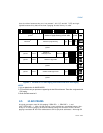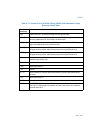
Vol. 3 4-21
PAGING
A reference using a linear address that is successfully translated to a physical
address is performed only if allowed by the access rights of the translation; see
Section 4.6.
Figure 4-7 gives a summary of the formats of CR3 and the paging-structure entries
with PAE paging. For the paging structure entries, it identifies separately the format
of entries that map pages, those that reference other paging structures, and those
Table 4-10. Format of a PAE Page-Directory Entry that References a Page Table
Bit
Position(s)
Contents
0 (P) Present; must be 1 to reference a page table
1 (R/W) Read/write; if 0, writes may not be allowed to the 2-MByte region controlled by
this entry (depends on CPL and CR0.WP; see Section 4.6)
2 (U/S) User/supervisor; if 0, accesses with CPL=3 are not allowed to the 2-MByte region
controlled by this entry (see Section 4.6)
3 (PWT) Page-level write-through; indirectly determines the memory type used to access
the page table referenced by this entry (see Section 4.9)
4 (PCD) Page-level cache disable; indirectly determines the memory type used to access
the page table referenced by this entry (see Section 4.9)
5 (A) Accessed; indicates whether this entry has been used for linear-address
translation (see Section 4.8)
6Ignored
7 (PS) Page size; must be 0 (otherwise, this entry maps a 2-MByte page; see Table 4-9)
11:8 Ignored
M–1:12 Physical address of 4-KByte aligned page table referenced by this entry
62:M Reserved (must be 0)
63 (XD) If IA32_EFER.NXE = 1, execute-disable (if 1, instruction fetches are not allowed
from the 2-MByte region controlled by this entry; see Section 4.6); otherwise,
reserved (must be 0)


















